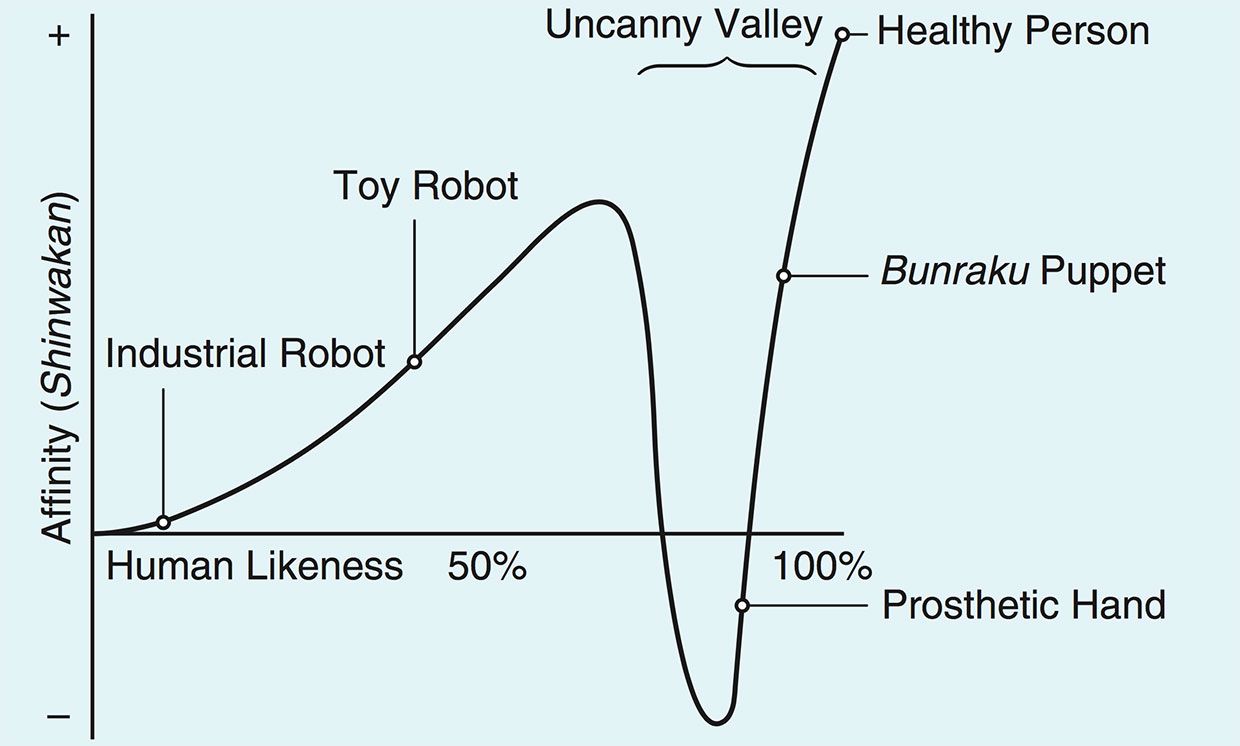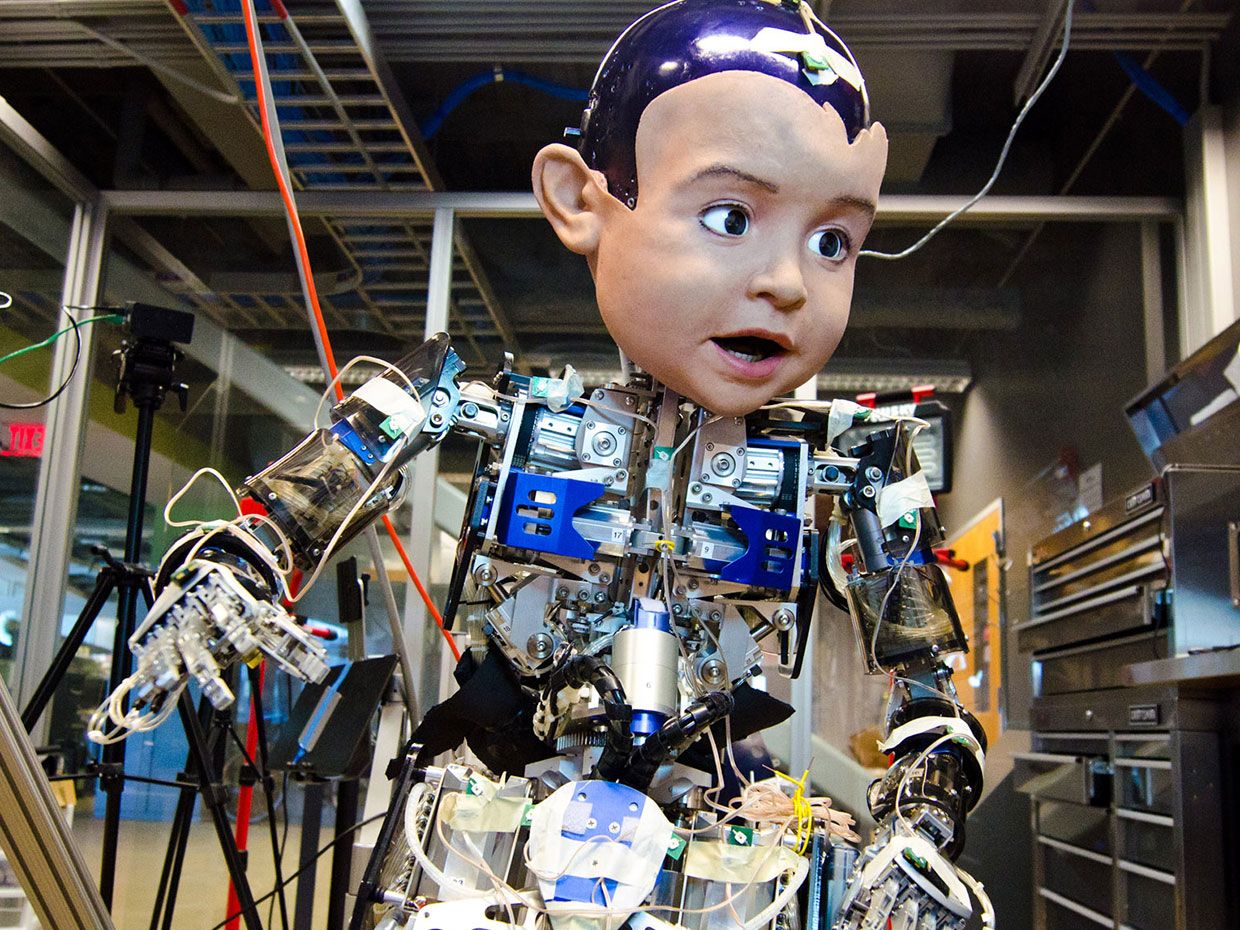
《公園の茅(ちがや)と野良猫さん!》
Mic Check はおそらくアメリカ大統領選挙の時、研究棟にこもっていて、よく大統領選挙関係の動画をYouTubeで視聴したり関連記事を読んでいたせいか、反トランプ陣営の若者たちがトランプさんが大統領に選出されて以降もアメリカの状況の報告記事を送ってきていて、久しく途絶えていた~。その当時のメンバーが引き継いで、ちょっと政治と文化をからめて中には必ず音楽を入れて再度送るようになっているのらしい。まめに全体を読むゆとりはなく、見出しで気になったのを少し目を通すくらいだが、その中に気になる熟語uncanny valleyがあった。なんと日本のロボット工学の先駆者森正弘さんの生み出した概念だったのだ。以下に紹介したGetRobotにはオリジナルの論考が紹介されていて分かりやすい。、英語バージョンはオリジナルのコピーである。
https://spectrum.ieee.org/automaton/robotics/humanoids/what-is-the-uncanny-valley ←このサイトからの抜き出しが以下ですが、ほとんど森先生の原文のコピーです。事例はちょっと異なります。森先生のオリジナルエッセイ(論考)はネットで読めます。https://www.getrobo.com/ GetRoboです。2012年のバージョンですが、森先生のインタビューも掲載されていて、以下の英文の理解に役たちます。この英文の具体的な事例は、アメリカ独特の視点でしょうか?森先生が指摘した日本のロボットたちとはまた異なりますが、わかりいいロボットたちです。文楽人形にたいする違和感のなさなど、なるほどです。またマネキンでも時に並んでいるのを見るとぞっとする感情が起こったりもしますので、人形そのものでも怖いと思う気持ち、あります。人間にそっくりなAIが登場すると、不気味の谷が起こりえるかもしれませんね。
思うに類似するロボット(AI)に対して不気味だと思う感情は、他にも応用できそうです。わたしたちは本能的に何に対して不気味だと思うのだろうか~。気になります。自らの幸せのために父親を殺そうとする娘は不気味だと思いますね。
https://ja.wikipedia.org/wiki/%E4%B8%8D%E6%B0%97%E5%91%B3%E3%81%AE%E8%B0%B7%E7%8F%BE%E8%B1%A1←こちらは『不気味の谷現象』ウィキピディアです。
https://ja.wikipedia.org/wiki/%E6%A3%AE%E6%94%BF%E5%BC%98←森政弘先生についてウィキピディアです。
何に対して『不気味』と感じるのだろうか?心の問題は解決されていないのだと森先生はインタビューで答えています。それゆえに仏教に傾倒されているとのことです。来月から座禅を組む予定ですが、コロナウィルスの問題が解決しない中で座禅も保留状態です。
Uncanny Valley: Definition and History
The uncanny valley is a concept first introduced in the 1970s by Masahiro Mori, then a professor at the Tokyo Institute of Technology. Mori coined the term “uncanny valley” to describe his observation that as robots appear more humanlike, they become more appealing—but only up to a certain point. Upon reaching the uncanny valley, our affinity descends into a feeling of strangeness, a sense of unease, and a tendency to be scared or freaked out. So the uncanny valley can be defined as people’s negative reaction to certain lifelike robots.生きた人間のようなロボットに対して不気味だと思う感情。
<figure class="xlrg" role="img"> <figcaption class="hi-cap">Image: Masahiro Mori</figcaption>
<figcaption>The uncanny valley graph created by Masahiro Mori: As a robot’s human likeness [horizontal axis] increases, our affinity towards the robot [vertical axis] increases too, but only up to a certain point. For some lifelike robots, our response to them plunges, and they appear repulsive or creepy. That’s the uncanny valley.</figcaption>
</figure>
<figcaption class="hi-cap">Image: Masahiro Mori</figcaption>
<figcaption>The uncanny valley graph created by Masahiro Mori: As a robot’s human likeness [horizontal axis] increases, our affinity towards the robot [vertical axis] increases too, but only up to a certain point. For some lifelike robots, our response to them plunges, and they appear repulsive or creepy. That’s the uncanny valley.</figcaption>
</figure>
In his seminal essay for Japanese journal Energy, Mori wrote:
I have noticed that, in climbing toward the goal of making robots appear human, our affinity for them increases until we come to a valley, which I call the uncanny valley.
Later in the essay, Mori describes the uncanny valley by using an example—the first prosthetic hands:
One might say that the prosthetic hand has achieved a degree of resemblance to the human form, perhaps on a par with false teeth. However, when we realize the hand, which at first site looked real, is in fact artificial, we experience an eerie sensation. For example, we could be startled during a handshake by its limp boneless grip together with its texture and coldness. When this happens, we lose our sense of affinity, and the hand becomes uncanny.
In an interview with IEEE Spectrum, Mori explained how he came up with the idea for the uncanny valley:
“Since I was a child, I have never liked looking at wax figures. They looked somewhat creepy to me. At that time, electronic prosthetic hands were being developed, and they triggered in me the same kind of sensation. These experiences had made me start thinking about robots in general, which led me to write that essay. The uncanny valley was my intuition. It was one of my ideas.”直感、発明(これはオリジナルからの引用です。)
Uncanny Valley Examples(ここからは事例です。森先生が指摘した事例とはちょっと異なりますが、興味深いです。)
To better illustrate how the uncanny valley works, here are some examples of the phenomenon. Prepare to be freaked out.
1. Telenoid
<figure class="xlrg" role="img"> <figcaption class="hi-cap">Photo: Hiroshi Ishiguro/Osaka University/ATR</figcaption>
</figure>
<figcaption class="hi-cap">Photo: Hiroshi Ishiguro/Osaka University/ATR</figcaption>
</figure>
Taking the top spot in the “creepiest” rankings of IEEE Spectrum’s Robots Guide, Telenoid is a robotic communication device designed by Japanese roboticist Hiroshi Ishiguro. Its bald head, lifeless face, and lack of limbs make it seem more alien than human.
2. Diego-san
<figure class="xlrg" role="img"> <figcaption class="hi-cap">Photo: Andrew Oh/Javier Movellan/Calit2</figcaption>
</figure>
<figcaption class="hi-cap">Photo: Andrew Oh/Javier Movellan/Calit2</figcaption>
</figure>
Engineers and roboticists at the University of California San Diego’s Machine Perception Lab developed this robot baby to help parents better communicate with their infants. At 1.2 meters (4 feet) tall and weighing 30 kilograms (66 pounds), Diego-san is a big baby—bigger than an average 1-year-old child.
“Even though the facial expression is sophisticated and intuitive in this infant robot, I still perceive a false smile when I’m expecting the baby to appear happy,” says Angela Tinwell, a senior lecturer at the University of Bolton in the U.K. and author of The Uncanny Valley in Games and Animation. “This, along with a lack of detail in the eyes and forehead, can make the baby appear vacant and creepy, so I would want to avoid those ‘dead eyes’ rather than interacting with Diego-san.”
3. Geminoid HI
<figure class="xlrg" role="img"> <figcaption class="hi-cap">Photo: Osaka University/ATR/Kokoro</figcaption>
</figure>
<figcaption class="hi-cap">Photo: Osaka University/ATR/Kokoro</figcaption>
</figure>
Another one of Ishiguro’s creations, Geminoid HI is his android replica. He even took hair from his own scalp to put onto his robot twin. Ishiguro says he created Geminoid HI to better understand what it means to be human.双子のロボットです!全くそっくりの双子に不気味と感じることが~?
4. Sophia
<figure class="xlrg" role="img"> <figcaption class="hi-cap">Photo: Mikhail Tereshchenko/TASS/Getty Images</figcaption>
</figure>
<figcaption class="hi-cap">Photo: Mikhail Tereshchenko/TASS/Getty Images</figcaption>
</figure>
Designed by David Hanson of Hanson Robotics, Sophia is one of the most famous humanoid robots. Like Soul Machines’ AVA, Sophia displays a range of emotional expressions and is equipped with natural language processing capabilities.感情が表示されているのですね。ことばも~。
5. Anthropomorphized felines
The uncanny valley doesn’t only happen with robots that adopt a human form. The 2019 live-action versions of the animated film The Lion King and the musical Cats brought the uncanny valley to the forefront of pop culture. To some fans, the photorealistic computer animations of talking lions and singing cats that mimic human movements were just creepy.(ぞっとする!)
Are you feeling that eerie sensation yet?
Uncanny Valley: Science or Pseudoscience?(科学、疑似科学?)
Despite our continued fascination with the uncanny valley, its validity as a scientific concept is highly debated. The uncanny valley wasn’t actually proposed as a scientific concept, yet has often been criticized in that light.
Mori himself said in his IEEE Spectrum interview that he didn’t explore the concept from a rigorous scientific perspective but as more of a guideline for robot designers:
Pointing out the existence of the uncanny valley was more of a piece of advice from me to people who design robots rather than a scientific statement.アドバイス、忠告
Karl MacDorman, an associate professor of human-computer interaction at Indiana University who has long studied the uncanny valley, interprets the classic graph not as expressing Mori’s theory but as a heuristic for learning the concept and organizing observations.
“I believe his theory is instead expressed by his examples, which show that a mismatch in the human likeness of appearance and touch or appearance and motion can elicit a feeling of eeriness,” MacDorman says. “In my own experiments, I have consistently reproduced this effect within and across sense modalities. For example, a mismatch in the human realism of the features of a face heightens eeriness; a robot with a human voice or a human with a robotic voice is eerie.”不気味
How to Avoid the Uncanny Valley
Unless you intend to create creepy characters or evoke a feeling of unease, you can follow certain design principles to avoid the uncanny valley. “The effect can be reduced by not creating robots or computer-animated characters that combine features on different sides of a boundary—for example, human and nonhuman, living and nonliving, or real and artificial,” MacDorman says.
To make a robot or avatar more realistic and move it beyond the valley, Tinwell says to ensure that a character’s facial expressions match its emotive tones of speech, and that its body movements are responsive and reflect its hypothetical emotional state. Special attention must also be paid to facial elements such as the forehead, eyes, and mouth, which depict the complexities of emotion and thought. “The mouth must be modeled and animated correctly so the character doesn’t appear aggressive or portray a ‘false smile’ when they should be genuinely happy,” she says.
For Christoph Bartneck, an associate professor at the University of Canterbury in New Zealand, the goal is not to avoid the uncanny valley, but to avoid bad character animations or behaviors, stressing the importance of matching the appearance of a robot with its ability. “We’re trained to spot even the slightest divergence from ‘normal’ human movements or behavior,” he says. “Hence, we often fail in creating highly realistic, humanlike characters.”難しいですね。人間に似せれば似せるほど逆な現象も~。uncanny valleyが~。
But he warns that the uncanny valley appears to be more of an uncanny cliff. “We find the likability to increase and then crash once robots become humanlike,” he says. “But we have never observed them ever coming out of the valley. You fall off and that’s it.”不気味な谷が不気味な崖に?ロボットが人間のようになる時にcrash(崩壊)が?
(英文の定義をこちらにサイトを紹介して一部UPしているのですが、削除される可能性もあるかと思います。実際のサイトをクリックしてください。オリジナル原文がサイトで紹介されていますのでそれも上に紹介しています。)uncanny valleyがなぜか気になったのですが、21世紀初頭から注目されていたのですね、ただ人形に対して不気味に感じる感性があって、たとえばお能の面に対しても一種感情が引き立てられる現象とも関係するように思えます。能面のもつ抽象性が引き立てるもの~。人間が面をかぶって唱え、踊り物語を身体動作で描いていきます。芸術作品と、文楽もそうですが実際のロボットとの差異は大きいでしょう。鑑賞する対象と日常で関わり合うロボット!



















